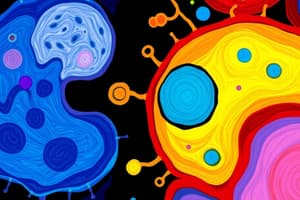Podcast
Questions and Answers
What is natural selection?
What is natural selection?
The process that drives evolution, favoring advantageous traits and eliminating detrimental ones.
Define adaptation.
Define adaptation.
The process by which organisms evolve specific traits to better survive in their environment.
What are the two main types of cells in living organisms?
What are the two main types of cells in living organisms?
Prokaryotic and eukaryotic cells.
Explain the role of decomposers in an ecosystem.
Explain the role of decomposers in an ecosystem.
What is the function of chloroplasts in plants?
What is the function of chloroplasts in plants?
What is homeostasis?
What is homeostasis?
Explain the role of feedback mechanisms in homeostasis.
Explain the role of feedback mechanisms in homeostasis.
What is evolution?
What is evolution?
What is genetic variation and why is it important for evolution?
What is genetic variation and why is it important for evolution?
Give an example of a control system involved in homeostasis.
Give an example of a control system involved in homeostasis.
Flashcards are hidden until you start studying
Study Notes
Exploring Edexcel IGCSE Biology: Homeostasis, Evolution, Cell Structure, and Ecosystems
The International General Certificate of Secondary Education (IGCSE) Biology course, specifically the Edexcel syllabus, offers an engaging and comprehensive exploration of living organisms and their environments. To effectively understand this subject, we'll dive into the essential topics of homeostasis, evolution, cell structure, and ecosystems, which form the cornerstone of this program.
Homeostasis
Homeostasis refers to the ability of living organisms to maintain a stable internal environment, despite changes in their external environment. Key concepts to understand include:
- Feedback mechanisms: One of the primary ways that living organisms regulate their internal environment, involving positive and negative feedback loops.
- Control systems: The regulation of homeostasis through control systems, such as the hypothalamic-pituitary-adrenal (HPA) axis and the fight-or-flight response.
- Examples: The regulation of body temperature (thermoregulation), blood glucose levels (glucostasis), and various other physiological processes.
Evolution
Evolution is the process by which species change over time through genetic variation, natural selection, and the survival of more fit organisms. Key concepts to understand include:
- Genetic variation: The basis of evolution, generated through mutation, gene flow, and genetic recombination.
- Natural selection: The process that drives evolution, favoring advantageous traits and eliminating detrimental ones.
- Adaptation: The process by which organisms evolve specific traits to better survive in their environment.
- Examples: The evolution of the human eye, the structure of the bat's wing, and the development of antibiotic resistance in bacteria.
Cell Structure
Cells are the fundamental units of life, and understanding their structure and function is a central aspect of IGCSE Biology. Key concepts to understand include:
- Prokaryotic and eukaryotic cells: The two main types of cells in living organisms, differing in cell structure and organization.
- Organelles: The specialized structures within eukaryotic cells, such as the nucleus, mitochondria, and chloroplasts.
- Membranes: The lipid bilayer that delineates cells and organelles, regulating the movement of substances in and out of these structures.
- Examples: The structure and function of the chloroplasts in plants, the role of mitochondria in energy production, and the function of the ribosomes in protein synthesis.
Ecosystems
Ecosystems are complex systems that encompass all living and non-living components and interactions that occur within a specific area. Key concepts to understand include:
- Biotic factors: The living components of an ecosystem, such as plants, animals, and microorganisms.
- Abiotic factors: The non-living components of an ecosystem, such as water, air, and soil.
- Energy flow and nutrient cycling: The transfer of energy and the recycling of nutrients through a food web and nutrient cycle.
- Examples: The role of decomposers in breaking down dead organisms and returning nutrients to the ecosystem, the role of herbivores in controlling plant populations, and the role of predators in maintaining ecosystem balance.
In summary, Edexcel IGCSE Biology offers a comprehensive understanding of living organisms and their environments, covering essential topics such as homeostasis, evolution, cell structure, and ecosystems. By studying these key concepts, students will develop a deep appreciation and understanding of the natural world.
Studying That Suits You
Use AI to generate personalized quizzes and flashcards to suit your learning preferences.



